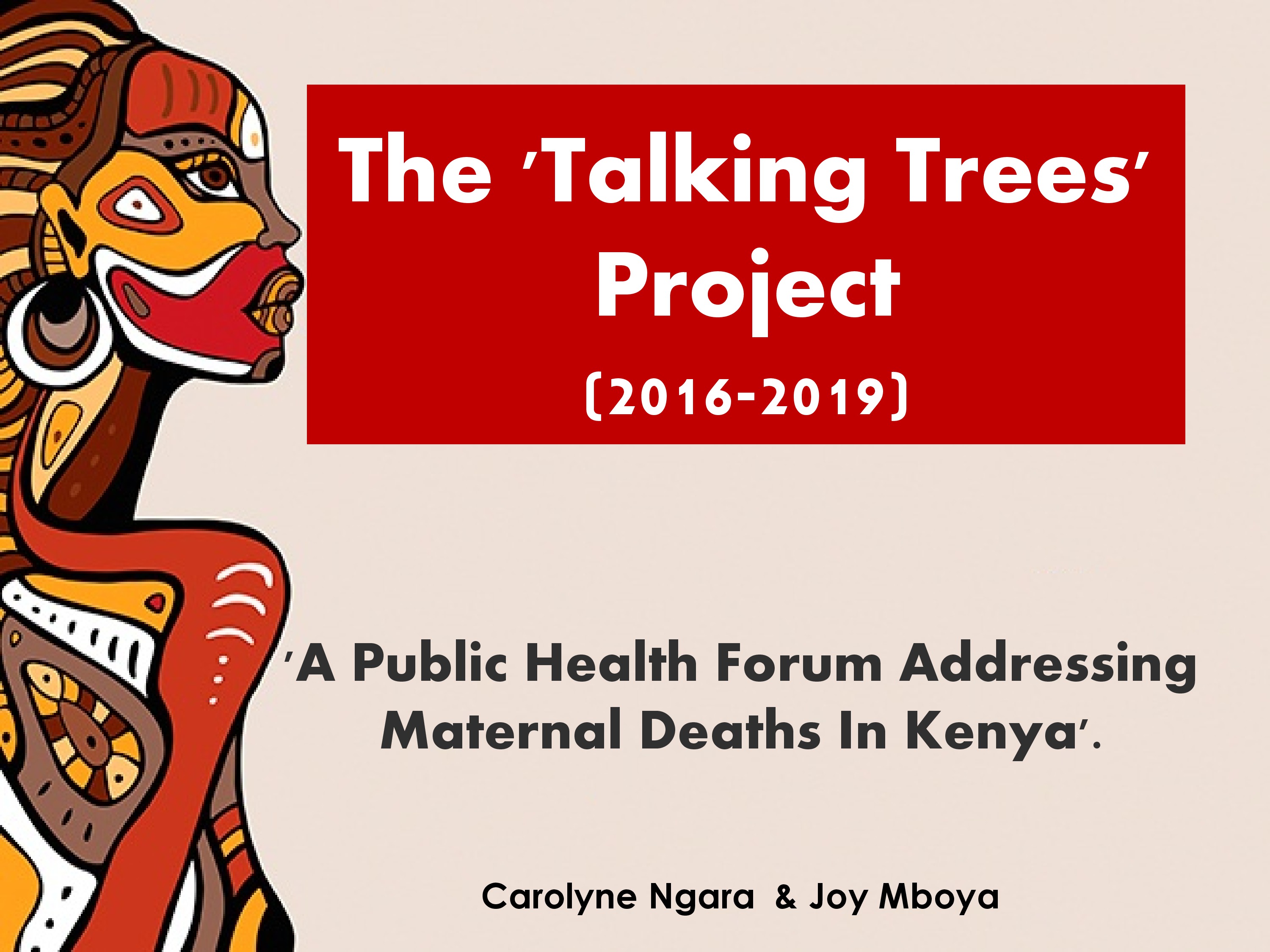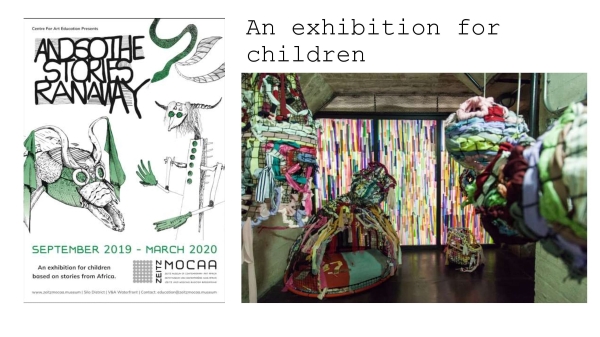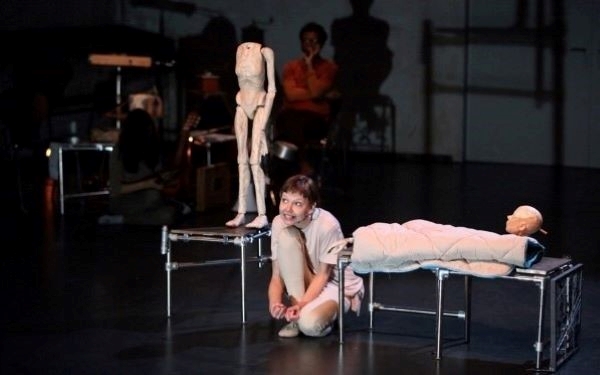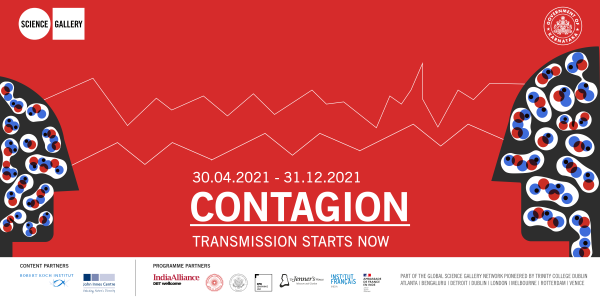Introduced by: Anastasia Koch, Eh!woza, South Africa
In our second workshop held in October 2021, we looked at the realities of planning and managing an interdisciplinary engagement project. Who sets the agenda and how do you negotiate differing ambitions and motivations within a team? We heard from Connectors who shared their experiences, learning and top-tips.
Working in parallel sessions, participants at the workshop also discussed some of the common challenges experienced by those running collaborative projects and also began to share solutions. Graphic illustrator, Deon Hanns from Sanscribe, created drawings of the discussions as they evolved.
Session 1: Who sets the agenda?
Guest facilitator: Zandile Ciko, Public Participations & Engagement Specialist, South Africa
Outlining the theme of the first session, Zandile Ciko discussed the impact of power dynamics between collaborators when setting up a new engagement project. She mentioned the importance of who takes control and sets the approach to the project and highlighted the value of having a set of desired project outcomes that are agreed upon by all those running the project. Our first case study presentation followed which described a culturally complex interdiscipinary project in rural Kenya.
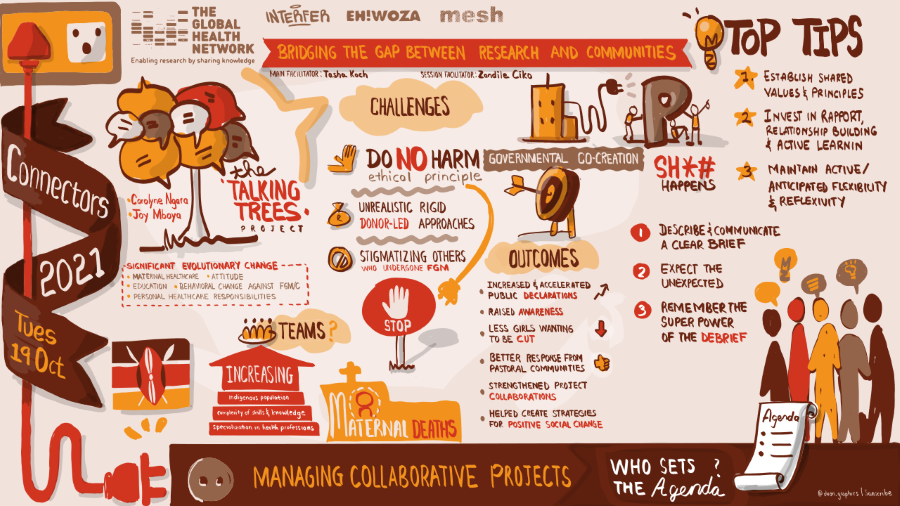
CASE STUDY 1 - Cultural complexity: Talking Trees
Carolyne Ngara, Institute of Anthropology, Gender and African Studies, University of Nairobi and Joy Mboya, Project Co-ordinator at the Reproductive Health Network Kenya (RHNK) gave a case study presentation on their project 'Talking Trees' which brought together a large number of partners to address maternal deaths amoung pastoralist communities and particularly to tackle the difficult topic of female genital mutilation or cutting (FGM/C). Carolyne and Joy described the interdisciplinary nature of the project and the how it was based on open communication, shared decision-making and sense of purpose. They described how funder objectives within this space can be out of sync with local cultural realities and how using a "DO NO HARM" approach helped them to negotiate these tensions. Click on the image below to open the full presentation slides [PDF, 1MB]
Access the team's paper “DO NO HARM”: Female Genital Mutilation And Its Effects On Women And Young Girls.
Read the Mesh project report on Cultural complexity and Talking Trees
Find out more about the Reproductive Health Network Kenya (RHNK)
TOP-TIPS PLANNING A NEW PROJECT - Sharing from experience
Nabeel Petersen, Director of Interfer & Co-founder of the Pivot Collective, South Africa gave us his three top-tips or considerations for managing a collaborative engagement project. He described his work at Pivot Collective and Interfer and the focus on participation, creativity and egalitarianism. Nabeel discussed the importance of establishing shared values and principles at the start of the project and this is an 'operational culture' or way or working. He also highlighted the need to always focus on active learning and learning with others to support flexibility.

Interfer is an arts-based collaborative social enterprise that strives to positively co-disrupt systems of exclusion and hegemony through innovative arts, research, engagement and other programmes. Find out more about INTERFER.
The Pivot Collective is a collaborative non-profit organisation focused on improving knowledge translation between research, engagement, policy, and practice. Find out more about The Pivot Collective.
Kim Darley Waddilove, Communications Officer at the Sub-Saharan African Network for TB/HIV Research Excellence (SANTHE), South Africa shared her top-tips for planning a collaborative engagement project and gave strong practical advice outlining the importance of a project brief and clear delineation of roles and responsibilities. Kim built on Nabeel's reflections on the the need to plan for unexpected changes. She concluded by stressing the importance of a debrief at the end of project looking at what worked and what didn't work so well.
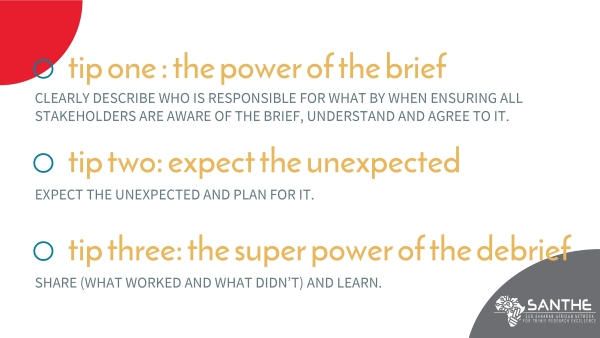
SANTHE is a Sub-Saharan African network of African-led research in HIV (particularly acute HIV (AHI)) and Tuberculosis (TB) infection. They aim to shape and drive locally relevant basic, clinical and translational research in Africa. Find out more about SANTHE
Read Kim's Mesh project report on COVID-19: Where Art and Science Meet
QUESTION: “What is your top-tip for planning a multi-partner interdiscipinary engagement project?”
Workshop participants were asked to add their own advice for planning and managing collaborative engagement projects. Zandile hightlighted the importance of open communication, transparency and understanding the limitations for each partner. Here are some of other participant responses:

Lifeology have a free flashcard course to help researchers and others to prepare for a successful Science-Art Collaboration
FULL RECORDING OF SESSION 1
SESSION 2: Addressing Challenges
Guest facilitator: Siân Aggett, Participatory Arts and Engagement Practitioner, Researcher & Evaluator, UK
Our facilitator for the second session, Siân Aggett, gave workshop participants some background and context to the theme of the session which sought to explore the common challeges experienced in interdiscipinary engagement projects. She outlined the challenges most mentioned in the Connectors community consultation and stressed the need to explore the drivers or route causes of these towards looking for solutions. In describing her professional background, Siân described the huge differences between arts research and medical research and how this divergence makes collaborative engagement projects using the arts so challenging. She described how many Connectors find themselves working within 'hierarchies of knowledge' where certain approaches/world views are naturally given more power.
"Connectors often find themselves working within 'hierachies of knowledge', where certain world-views are naturally given more power"
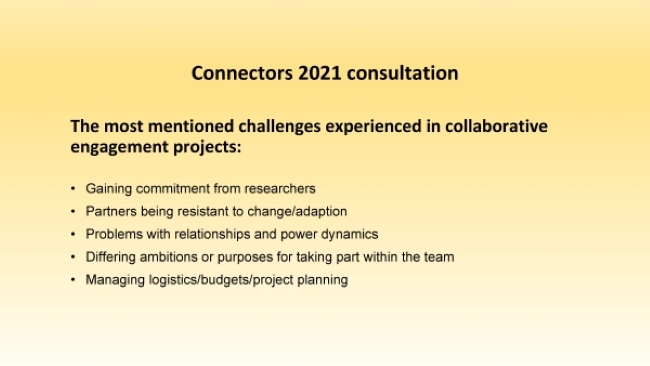
PARALLEL DISCUSSION SESSIONS - Challenges in collaborative engagement projects
Participants were divided into three breakout groups to hear from speakers who gave some insights into creative projects they had managed, working with different partners, and the challenges they encountered. Groups discussed how these issues came about, the dynamics at play and any solutions that were found. During the plenary discussion following the break-out groups, participants shared a series of reflections and points that arose from their sessions.
Richard Kilpert, Art Educator at Zeitz Museum of Contemporary African Art (Zeitz MOCAA), South Africa
Richard described a project which was an interactive commission for museum display that was aimed at young peopole and families. Students were asked to create work exploring stories from Africa, tapping into children's and folk tales. The process uncovered cultural and racial sensitivies around ownership over these stories and this was a barrier for some young people who found it hard to take part and represent themselves. The solution to the challenge was spending a lot more time sharing and uncovering the stories, allowing those more hesitant young people to get involved. This new timescale presented another challenge operationally and financially.
Working within the rules and boundaries of a large arts institution also presented a challenge particularly when it came to public access to an installation that had not been curated by museum staff in a location that is not accessible to all demographics in the city. They overcame this by funding transport to allow visitors to access the museum and ultimately by making the exhibition mobile to reach communities. Find out more about Zeitz MOCAA. Click on the image below to open the full presentation slides [PDF, 6.37 MB]
Stacy Hardy, Writer, journalist, artist and Performer, South Africa
Stacy outlined a project that she began following her recovery from TB in 2018. Based on her experience, she developed a play that asked questions about the precariousness of bodies, highlighting the colonial and systemic racial structures as well as the violence of healthcare and political systems. Following this she was approached by anthropologist Kaushik Sunder Rajan, University of Chicago, and together with composer Neo Muyanga they developed a research- and performance-based collaborative endeavor exploring biographies and geographies of breath. Their plan to present a series of performance lectures was postponed by the pandemic. Unable to meet, they continued to correspond and conspire over email. This exchange developed into a epistolary novel published online by Haus der Kulturen der Welt. In many of their exchanges they shared reading and listening material, which formed the basis of a syllabus for a course at the University of Chicago. Stacy described the very different backgrounds of those in the project team and encouraged others to think carefully about form. What form should the project take? How can form be used in an exciting way? She urged us to think outside our usual formulas and allow new forms to be created by working with others across disciplines. Click on the image below to open Pulmonographies, the final syllabus created from the collaborative project [PDF, 60KB]
Madhushree Kamak, Programme Manager at Science Gallery Bengaluru, India
Madhushree discussed the challenge of taking engagement online espcially in the context of the pandemic in the last year and a half. She described the difficulties of re-creating work for the digital space and providing public engagement experiences that are not face to face. This often meant moving from two-way to one-way flows of communication, using new tools and managing people's resistance to the new methods. Madhushree reflected on how power changes with use of tecnhology and the extra work required for Connectors to make this transition easier for other project partners and the public audience. Gaining committment from researchers and other experts remains a constant challenge again where the extra work required to solve the issue often sits with Connectors. Find out more about Science Gallery Bengaluru. Click on the image below to open the online exhibition and see the outputs from the project
Explore Mesh resources on designing and facilitating virtual events and other methods of engaging at a distance, including radio, social media and online platforms: Engagement at a distance
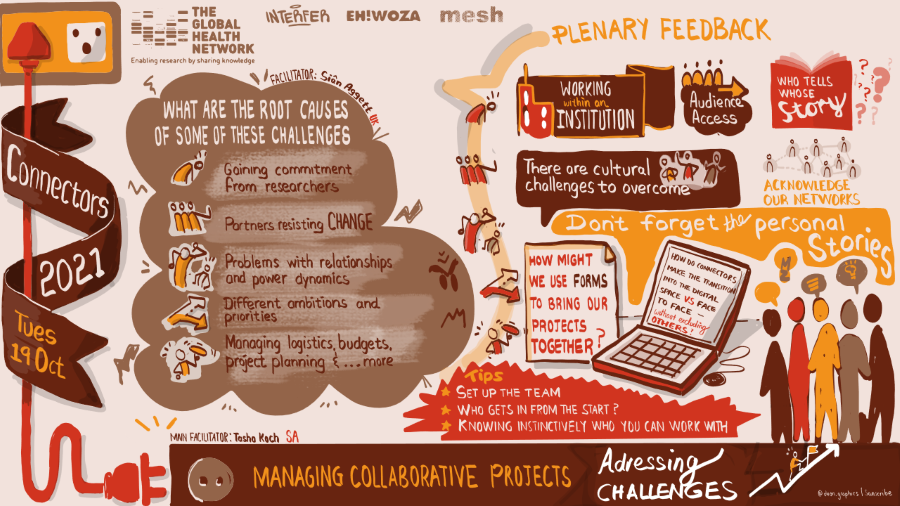
Final reflections - Dorcas Kamuya, Head of Health Systems and Research Ethics at KEMRI-Wellcome Trust Research Programme, Kenya
Dorcas gave her reflections on the discussions during the workshop and began by reinforcing the need to invest in relationships very early within interdiscipinary projects. She stressed that it is easy to believe that those sound relationships within a team will evolve organically, but that this is not always the case. When setting up a team we need to think about who is involved and their role, for example, are the communities beneficaries or are they part of the project team? This can set key elements that last throughout the project, such as whether you are creating power or breaking it down. Dorcas concluded by highlighting the need to maintain reflexivity and to continiously learn from one another.
The KEMRI | Wellcome Trust Research Programme is a world renowned health research unit of excellence. They are state of the art facility hosting over 100 research scientists and 700 support staff working across Kenya, Uganda and the region. Find out more about Professor Kamuya.
"We must embrace interdisciplinarity and find the opportunities it provides for us"
FULL RECORDING OF SESSION 2
Graphic illustrations | Deon Hanns, Sanscribe (LinkedIn), South Africa
Return to the Connectors main page
This work is licensed under a Creative Commons Attribution 4.0 International License

